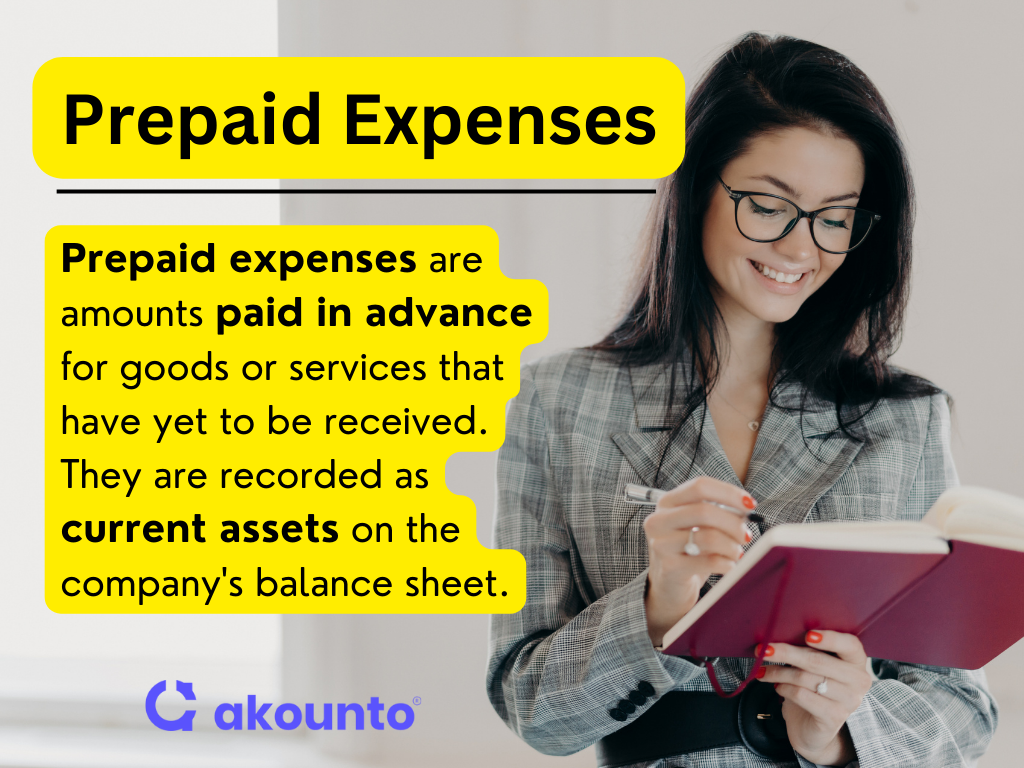What is Prepaid Expenses in Accounting?
Prepaid expenses are amounts paid in advance for goods or services that have yet to be received. They are recorded as current assets on the company’s balance sheet.
In standard business operations, prepaid expenses do occur where a company has to make cash payment in a lump sum for the benefits it is to receive in the future.
The common prepaid expense example can be insurance expense, where prepaid insurance is paid at a time, and the insurance coverage can cover more than one accounting period.
By paying in advance, the company benefits as the obligatory expenses are met, and forecasting and planning expenses become easier.

Prepaid Expenses in the Financial Statements
The recognition of prepaid expenses in the company’s financial statements is based on the “matching principle.” A prepaid expense incurred is represented on the balance sheet and the income statement.
The guidelines by GAAP (Generally Accepted Accounting Principles) govern the recognition and classification of a prepaid expense, and guidelines by the IRS (Internal Revenue Service) govern the tax treatment for prepaid expenses.
GAAP lays down the concept of the matching principle, according to which the revenue and expenses should be recorded in the same accounting period when the consideration for it is actually received or delivered.
The revenue recognition (AS 606) stipulates that the revenue should be recognized in that accounting period when the value for it is actually delivered to the customer. Suppose the income is received in advance and the service or good is to be delivered in a future period. In that case, the income will be recorded as a liability in that period and will be recognized in the income statement only when the corresponding service is delivered.
Similarly, in the case of prepaid expenses, the expenses incurred will be a current asset for the financial period when they are incurred; as and when the benefits will be received in the future periods, the corresponding amount will be shifted to the company’s income statement in the later accounting period.
The principles mentioned above are the basic concepts of the accrual basis of the accounting method.
The recording of prepaid expenses in the financial statements is as follows:
Balance Sheet
In the company’s balance sheet, the prepaid expenses are recorded as a current asset account. Prepaid expenses recorded as current assets because the company is legally entitled to receive the future benefits for which it has paid in advance.
Income Statement
The prepaid expenses are recorded in the company’s books as per the GAAP guidelines. The expenses can be recognized only in the period when the benefits of the expenses are received. Till then, they will be shown as current assets on the balance sheet.
Prepaid Expense Amortization
Prepaid expense amortization is gradually reducing the prepaid amount to zero over time in correspondence to the benefits received. The corresponding amount of prepaid expense is transferred from the Balance Sheet (Current asset account) to the Income Statement.
The allocation is done according to the amortization schedule.
Tax Treatment of Prepaid Expenses according to IRS
IRS has given two sections for dealing with the tax treatment of a prepaid expense Reg. Sec. 1.162-3(d) and Reg. Sec. 1.263(a)-4(f). The first section deals with the general treatment, while the second one is the exceptional treatment (commonly known as the 12-month rule)
General Tax Treatment
The general tax treatment by the IRS (Reg. Sec. 1.162-3(d)) does not allow full tax deductions in the same year if the benefits are not received in the same accounting period. It permits the capitalization of a prepaid expense, which is spread over a number of accounting periods
12-Month Rule and Prepaid Expenses
The 12-Month Rule (Reg. Sec. 1.263(a)-4(f)) says that the taxpayer can claim the expenses for tax deductions in the conditions where the earlier of the two can be taken :
- When the benefits arising from prepaid expenses do not go beyond 12 months.
- The benefit of the prepaid expense does not go beyond the tax year, which comes after the tax year in which a prepaid expense is incurred. For example, if a prepaid expense is incurred in the 2023-24 financial period/ tax year. The benefit should not go beyond the end of the financial year/ tax year 2024-2025.
Examples of Prepaid Expenses

Some common examples of prepaid expenses are:
- Prepaid insurance expenses.
- Annual rent expense.
- Retainer expenses incurred for legal services.
- Lease payments for machinery or equipment.
- License payments.
- Franchisee Fee
Working Examples of a Prepaid Expense
A company enters a contract with a real estate company to use office space for $ 5000 per month. The company signs a 3-year contract. The rental contract requires the company to pay the complete rent expense as an annual payment for 3 years as a lump sum amount.
Thus, the company pays an upfront amount, which becomes a prepaid rent expense.
For ease of calculation and understanding, let us assume that the lump sum is paid in advance in the first month of the first accounting year. So, the benefits of prepaid rent cover a total of 3 accounting periods.
Total prepaid rent = $ 5000 * 36 months = 1,80,000
Prepaid Rent for Year 1 = $ 60,000
Prepaid Rent for Year 2 = $ 60,000
Prepaid Rent for Year 3 = $ 60,000
The recording of Prepaid expenses is as follows:
|
Prepaid Expense Amortization |
||
|
Year 1 |
Prepaid Expense in Balance Sheet |
Expense Transferred to Profit and Loss Account / Income Statement |
|
Month 0 |
180000 |
0 |
|
Month 1 |
175000 |
5000 |
|
Month 2 |
170000 |
5000 |
|
Month 3 |
165000 |
5000 |
|
Month 4 |
160000 |
5000 |
|
Month 5 |
155000 |
5000 |
|
Month 6 |
150000 |
5000 |
|
Month 7 |
145000 |
5000 |
|
Month 8 |
140000 |
5000 |
|
Month 9 |
135000 |
5000 |
|
Month 10 |
130000 |
5000 |
|
Month 11 |
125000 |
5000 |
|
Month 12 |
120000 |
5000 |
| В | В |
Total = $ 60,000 |
|
Prepaid Expense Amortization |
||
|
Year 2 |
Prepaid Expense in Balance Sheet |
Expense Transferred to Profit and Loss Account / Income Statement |
|
Month 1 |
115000 |
5000 |
|
Month 2 |
110000 |
5000 |
|
Month 3 |
105000 |
5000 |
|
Month 4 |
100000 |
5000 |
|
Month 5 |
95000 |
5000 |
|
Month 6 |
90000 |
5000 |
|
Month 7 |
85000 |
5000 |
|
Month 8 |
80000 |
5000 |
|
Month 9 |
75000 |
5000 |
|
Month 10 |
70000 |
5000 |
|
Month 11 |
65000 |
5000 |
|
Month 12 |
60000 |
5000 |
| В | В |
Total = $ 60,000 |
|
Prepaid Expense Amortization |
||
|
Year 2 |
Prepaid Expense in Balance Sheet |
Expense Transferred to Profit and Loss Account / Income Statement |
|
Month 1 |
55000 |
5000 |
|
Month 2 |
50000 |
5000 |
|
Month 3 |
45000 |
5000 |
|
Month 4 |
40000 |
5000 |
|
Month 5 |
35000 |
5000 |
|
Month 6 |
30000 |
5000 |
|
Month 7 |
25000 |
5000 |
|
Month 8 |
20000 |
5000 |
|
Month 9 |
15000 |
5000 |
|
Month 10 |
10000 |
5000 |
|
Month 11 |
5000 |
5000 |
|
Month 12 |
0 |
5000 |
| В | В |
Total = $ 60,000 |
| В | В | В |
Prepaid Expenses Journal Entry
To explain the journal entries, let’s take a common example of prepaid expense: Rent Paid in Advance
When the rent is prepaid in advance, the following journal entries are passed to create a prepaid account and capitalize the future expenses as and when the benefits are received.
Journal Entry 1: Recording Payment in Cash/ Bank
| Date | Particulars | Debit | Credit |
| Prepaid Rent/ Prepaid Expense Dr. | XXXX | ||
| To Cash / Bank Account | XXXX | ||
| (Being rent paid in advance for the year or accounting period) |
The cash/asset account in the balance sheet will be credited (reduced), and the Prepaid Rent Account (Prepaid Asset Account) will appear as a Current Asset Account in the Balance Sheet.
Journal Entry 2: Capitalising the Rent/ Prepaid Expense when the benefit is received
| Date | Particulars | Debit | Credit |
| Rent Expense Account Dr. | |||
| To Prepaid Rent/ Prepaid Expense | |||
| (Being the expense transferred to the profit and loss account for the benefit received) |
In this journal entry, the Rent Expense Account is created, which will show as an expense in the Profit and Loss Account, and the same amount will reduce the Prepaid Rent Account (Current Asset Account). This is called capitalizing the prepaid expenses.
Difference Between Prepaid Expenses and Accrued Expenses
A prepaid expense is an expense made in advance for the benefits to be received in the future. It can be said that future expenses are done in a lump sum.
The prepaid expense account is a current asset account, and it has a debit balance. The prepaid expenses debits when the expenses are incurred and are credited when it is reduced, i.e., transferred to the profit and loss statement.
Accrued expenses are expenses that have yet to be incurred, even though the goods or services have already been received. An accrued expense account is a liability, which means that the company ought to pay them in the future. Like all liabilities, the accrued expense account has a credit balance.
Conclusion
Recording and capitalizing prepaid expenses as per the regulations by the IRS for tax benefits and GAAP for accounting consistency is essential, both in terms of legality and accounting integrity. It is important to understand prepaid expenses and their accounting treatment and avoid any errors that can lead to fines or penalties.
Visit Akount’s blog to learn more about finance and accounting topics, which will help you manage business finances efficiently.




